What is a Makerspace?
Posted by Network Support · Leave a Comment
What is a Makerspace?
A makerspace refers to a workstation where students collaborate, explore, share, make and learn. The facility generally located in the classroom or library, and can be equipped with tools ranging from high-tech to no-tech, with emphasis on stimulating students’ curiosity, discovery, creativity and invention.
Need for Makerspace
Makerspace originates from the works of Jean Piaget, and follows a constructionist and constructivist approach to learning. The aim of makerspaces is to promote self-directed learning, and encourage students to learn by interacting and manipulating physical objects.
At makerspaces, students gain plenty of hands-on learning experiences, develop their STEM (science, technology, engineering and math) skills, and explore higher cognitive skills like critical reasoning and problem-solving. Makerspaces encourage students to explore, develop and use their skills and imagination to spark entrepreneurship innovation, and help them to gain confidence in these areas.
Creating Makerspaces in the Classroom
In recent years, makerspaces have become part of the modern classroom environment. Here are some tips for setting up a makerspace in the classroom:
Selection of space: The area for a makerspace should be large enough to accommodate at least 3-4 students working together with room for furniture, storage and displays.
Gathering Resources: It is not necessary to equip the makerspace with only high-tech tools. Teachers can assemble a budget-friendly makerspace by collecting common and easily available household materials like cardboard, twine, thread, glue, ice sticks and other similar items. Teachers can make a wish list of required items and send copies of the list to parents for donations or contributions. Teachers can also connect with local service providers to obtain or rent the essential high-tech tools.
Makerspace Rules: Set down some ground rules to help students use the space in an effective and orderly manner. Some of these rules can be about:
- Timing: Specify the times (before, after or during class) when students can engage with makerspaces.
- Student schedule: Maintaining a student schedule ensures that all students get to use the makerspace equally. A schedule for individual and group work can be planned out and displayed on the bulletin board.
- Student responsibilities: Students can be held responsible for tidying up and replacing materials in their storage areas.
- Inventory: Instruct students to inform the teacher about resources that are low or depleted. Hang up an inventory chart, and have students record the materials that they have used. This information can help teachers replace materials efficiently.
Plan and preserve: Waste of materials and discontinuation of projects can be avoided by instructing students to plan and preserve. As a first step, students must plan and create a detailed project plan outlining the steps, materials required and expected waste. This way, students can always refer to the plan when they face any obstacles.
Inspiring students: Teachers can give students the freedom to decide and choose their projects, or inspire them with task cards that have project suggestions.
In makerspaces, students learn by doing. These workstations encourage students to push their skills, imagination and creativity to higher levels and allow them to become inventors and innovators on their own.
Like this article for teachers?
Browse the Professional Learning Board COURSE CATALOG to find related online courses for teachers in your state. Professional Learning Board is a leading provider of online professional development classes that teachers use to renew a teaching license or renew a teaching certificate.





